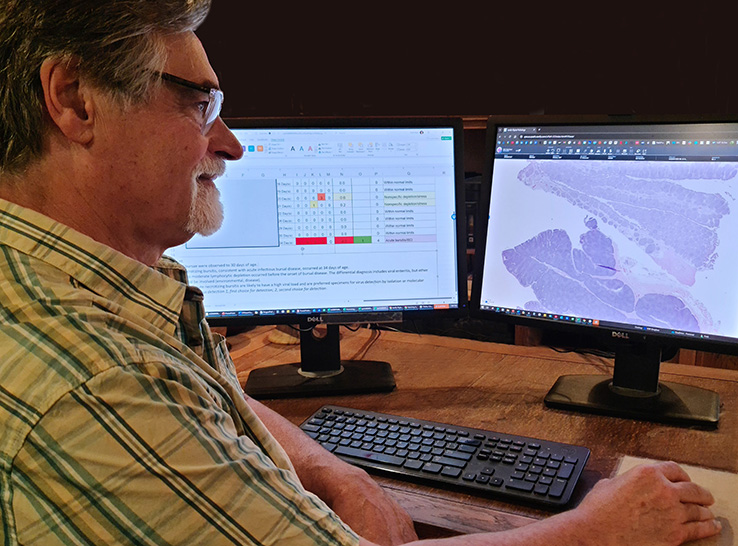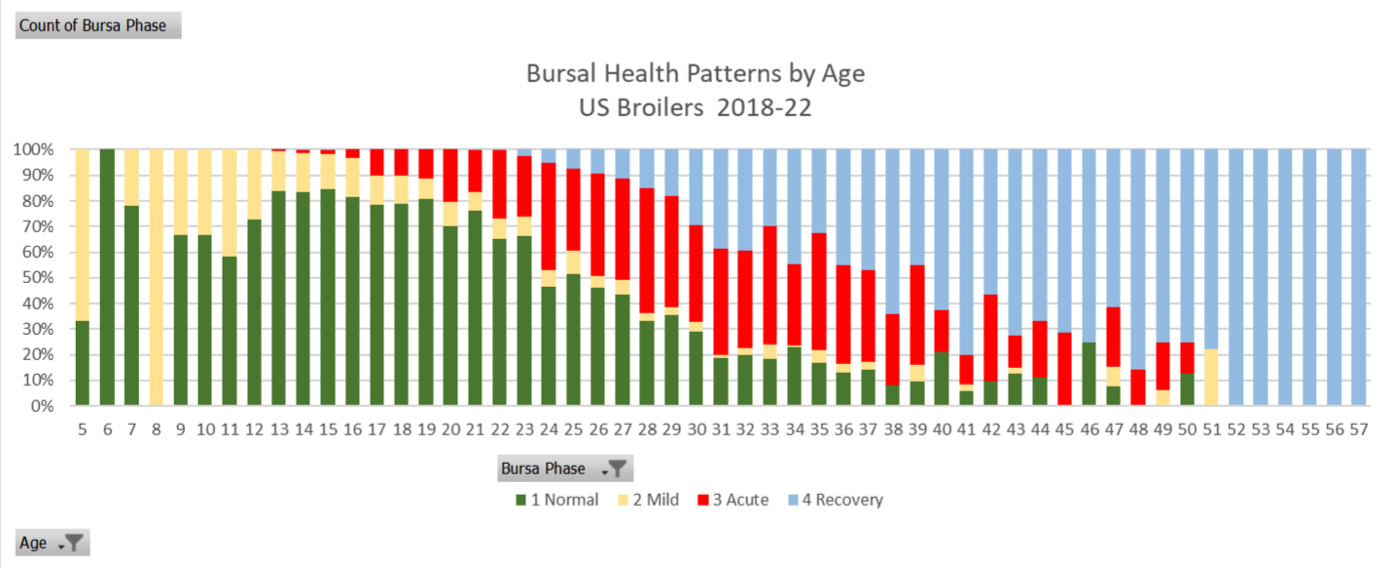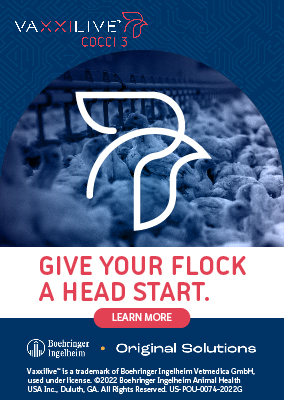 Virtually everyone involved with live poultry production knows the importance of protecting layer, breeder and broiler flocks against infectious bursal disease (IBD).
Virtually everyone involved with live poultry production knows the importance of protecting layer, breeder and broiler flocks against infectious bursal disease (IBD).
If left unchecked, it can cause listlessness, watery diarrhea, ruffled feathers and dehydration. Morbidity rate is high and mortality rate is usually low, though some virulent strains reportedly cause mortality rates of 60% or higher.1
Diagnostic pathologist Fred Hoerr, DVM, PhD, has dealt with IBD throughout his career and, over the years, has developed a unique perspective of the immunosuppressive disease.
“I see poultry production through the lens of the microscope,” says Hoerr, who owns Veterinary Diagnostic Pathology, LLC, which provides diagnostic services for poultry clients in the US and more than 40 other countries.
“I look at tissues from chickens and turkeys microscopically and then project out to the production system to try and understand what is actually going on there.”
Monitoring flock immunity
With 32 years of work in Alabama state diagnostic laboratories and now his own lab for 12 years, Hoerr is uniquely qualified to examine not only the health status of birds but also their ability to combat IBD and other diseases that compromise flock immunity and make birds more susceptible to other diseases.
Take broiler flocks, for example. According to Hoerr, it’s common to see early signs of disease in the digestive tract, but much of it is subclinical and often producers aren’t aware there’s a problem.
“As a pathologist, I’m looking at intestines microscopically,” he explains. “I can see that there are more problems out there than what people recognize — and it’s not just intestinal disease.
“These intestinal challenges produce some stress on the immune organs that you can see only microscopically.”
Clouded focus
The problem, Hoerr says, is that people tend to focus on the most common diseases that can be managed with vaccines. They’re not looking at the big picture and considering what other diseases are quietly working in the background to compromise flock immunity, performance and welfare.
One example is chicken anemia virus (CAV), an immunosuppressive disease that causes intramuscular hemorrhage, weight loss, anemia and bone marrow aplasia in young chickens. Hoerr says CAV has been occurring intermittently throughout broiler production in some pockets of the US. Reoviruses also impair the immune system.
In other cases, people forget that some common diseases are also immunosuppressive.
“Marek’s is primarily recognized as a tumor virus disease — one that causes processing-plant/carcass-quality issues — when, in fact, a very early infection by Marek’s disease leads to immunosuppression if chickens are not properly immunized against it,” Hoerr says. “Marek’s can affect the immune system through the bursa and thymus.”
Mycotoxins in feed, which tend to be regional and seasonal issues, can also weaken the immune function of birds.
“All these are rather subtle influences that, if you’re not asking the right questions, they can be occurring and you may not be aware of them,” Hoerr says.
Immunosuppressed flocks
Then there are problems that quietly emerge when the immune system isn’t functioning normally. For example, in immunosuppressed flocks, it’s common to see:
- Inclusion body hepatitis, caused by an adenovirus, is commonly seen in these compromised flocks and can lead to sudden increases in mortality;2
- Higher incidence of respiratory disease,particularly “in flocks where you’re not getting a clear-cut pathogen identification in birds that you take to the lab,” Hoerr says. “Usually, that’s a bird that’s just not handling its routine bacterial agents properly because the immune system isn’t working;”
- Gangrenous dermatitis, a bacterial disease of the skin seen in broilers, can be “quite problematic” in immunosuppressed flocks, the pathologist says. “With a little extra digging, we learned that a lot of those birds with this disease are immunosuppressed;”
- Coccidiosis flare-ups, despite well-planned efforts to manage control programs effectively.
Pinning the blame
Hoerr says veterinarians and production managers often want to pin the blame on vaccines or medications. Upon closer inspection, however, the problem with the flock is usually rooted in immunosuppression.
And just as there is no silver bullet for controlling a specific disease or syndrome, there is no single quick and easy diagnosis that will provide a clear snapshot of a flock’s health status.
Decision makers need to examine all the moving parts of the bird’s complex immune system when planning effective disease-management programs.
Role of veterinary pathologist
That’s where pathologists enter the picture. Early in his career, Hoerr became aware of the need to take a more holistic approach to diagnostics similar to performing safety studies for human pharmaceuticals that were initially tested in animals.
“Most people don’t realize that most of the safety studies for human pharmaceutical products and vaccines are done in animals by board-certified veterinary pathologists who work for either companies or contract research labs,” he says.
For periods of 6 to 24 months, veterinary pathologists identify and score virtually everything they can find microscopically in the tissues of rodents and guinea pigs.
“Then they do statistics and analyze the effect of that drug and try to determine whether the reaction is a background change or a drug-induced change. From there, they decide whether the reaction needs to be taken into account when evaluating the product’s safety,” he says.
Veterinary pathologists involved in safety studies can confidently draw conclusions because everything in the study is clearly defined — genetics, environments, diets, treatments and so on — to ensure a uniform laboratory-animal colony.
That’s when Hoerr realized that when it came to sampling consistency, laboratory-animal colonies weren’t much different from birds in commercial poultry production.
“I started applying similar toxicologic pathology assessment used in drug-safety studies to commercial poultry production” to learn about the evolution of diseases, he explains.
Starting with the bursa
In poultry, diagnosing immunosuppression usually begins by taking samples of the bursa of Fabricius — a small pouch located in the hindgut close to the cloaca, where B cells are formed in chickens — and testing them for IBD. But even then, incidence of IBD is never a yes-or-no question.
“What I can say is, yes, at this age you’ve got clean bursas. But then, a few days or weeks later, the birds start to get diseased. And then they start to recover from it. So, I take these data and put all of it into a large database. Now, all of a sudden, you can start making graphs of the onset and resolution of disease.
“So, this adds a different little twist to it, because now we’re looking at not only do you have a disease, but when does a disease start? How severe is it? And when does it resolve?”
Heat-mapping IBD outbreaks
To help him and producers better understand the impact of immunosuppression, Hoerr started charting the incidence and timing of IBD occurrences based on microscopic surveillance of immune organs. Poultry operations experiencing IBD outbreaks collect a sampling of bursas from the field and split them in half. One half is frozen and held for future virus studies, and the other half is sent to Hoerr’s lab for examination.
Hoerr then assigns a number to indicate bursal health based on the microscopic appearance of the bursa’s lymphoid follicles. The numbers for an operation are put into a database and then graphed to show disease onset and resolution.
The result is a colorful “heat map” of an IBD outbreak for the farm. Colors on the map illustrate the progress of an outbreak by age in a broiler operation (Figure 1).
Figure 1.
Source: Fred Hoerr
“Red is when the disease starts to appear…and then blue bars are bursas in the recovery phase,” Hoerr says. “You can get a nice heat map of how this disease progresses.”
Ripple effect
The information learned from heat maps has been eye-opening for poultry companies.
“If you get an immunosuppressive disease during the first 14 days, it’s really important because it interrupts the population of other immune centers in chickens that help them be immune-capable while going through production,” he explains.
“The chicken starts off with a normal bursa and is protected with a maternal antibody from the hen, which makes breeder vaccination important.”
Most chickens get vaccinated for respiratory diseases in the hatchery or soon thereafter with attenuated live-virus vaccines, which work by giving birds a mild case of the target disease to stimulate the bird’s natural immune system, which in turn clears the virus from the bird’s system.
“If they’re not clearing it properly, those vaccine viruses can come back to be a stress factor for the flock,” he explains. “So, this is where it’s important to walk through the chicken house — listening to the sounds of the chickens and making sure that they’re handling their vaccine reactions adequately.
“People give infectious bursal disease vaccines to chickens to prevent the disease…but what they really do more is influence the presentation of the disease,” Hoerr says. “They extend the age of protection until a field challenge breaks through so the birds can get a little older when they go through this reaction. Vaccines also decrease the severity of the disease and improve the recovery phase.”
Thymus connection
Another piece of information Hoerr learned was bursal disease at any age can affect different phases of the immune system, including the thymus. Years ago in the diagnostic lab, he noticed birds with a badly damaged bursa usually had a damaged thymus as well.
He followed up with a study of several hundred cases from the lab and found a clear connection between a severely damaged bursa, and a damaged thymus from another pathogen, chicken infectious anemia virus.
“I handed this over to the researchers at Auburn University (Haroldo Toro, DVM, PhD; Vicky van Santen, PhD; and Fritz van Ginkel, PhD) and they really dissected the interaction of these two diseases,” Hoerr reports. “They found that these two immune diseases are interactive and influence each other. They occur naturally in chickens in production.
“Now we have two arms of the immune system that may be damaged, and the damage seems to go hand in hand.”
Timing the inevitable IBD challenge
From what Hoerr can see, timing is key to combatting IBD and other immunosuppressive diseases.
“We have the tools to manage IBD. The question is when IBD is going to occur and how can we influence it,” he says.
“Keep in mind that in most flocks, IBD does not lead to mortality events. Immunosuppression from IBD and other diseases erodes the genetic potential of the bird to perform optimally.”
Using the IBD heat maps, Hoerr helps poultry producers move bursal disease reactions away from times when the birds are experiencing other stress factors. As a result, the birds are healthier and better able to mount an immune response. When they go through the bursal disease reaction, it has a smaller impact on the bird.
However, every operation is different when looking at immune stress levels, even within the same company and its production locations.
Surveying bursal health
Routine bursal surveys are now used by many poultry companies to monitor the immune health of the chickens and help them navigate their short lifespan successfully, Hoerr adds.
The payback for the bursal surveys is twofold. First, when a new virus appears, the producers will know it quickly and vaccine manufacturers can start the process of developing a vaccine.
Second, poultry companies can find the viruses that are breaking through their program and creating immune damage when the birds are very young.
“They can take those isolates and make autogenous vaccines to put into their breeder vaccination program,” Hoerr says. “Those antibodies are protective from bursal disease and can quickly influence that program.
“The message I’ve been trying to tell integrators based on the pathology is they can, to a degree, control this disease,” Hoerr adds. “They can actively manage IBD vaccination in the program when the birds go through the reaction at the best time.”
Editor’s note: Content on Modern Poultry’s Industry Insights pages is provided and/or commissioned by our sponsors, who assume full responsibility for its accuracy and compliance.
1 Infectious Bursal Disease in Poultry, Merck Veterinary Manual. https://www.merckvetmanual.com/poultry/infectious-bursal-disease/infectious-bursal-disease-in-poultry (Access date: May 13, 2024.)
2 Inclusion Body Hepatitis and Hepatitis Hydropericardium Syndrome in Poultry, Merck Veterinary Manual. https://www.merckvetmanual.com/poultry/inclusion-body-hepatitis-and-hydropericardium-syndrome/inclusion-body-hepatitis-and-hepatitis-hydropericardium-syndrome-in-poultry (Access date: May 13, 2024.)










